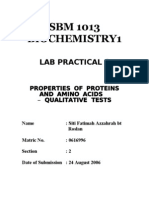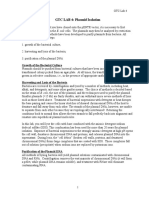Quantitative Determination of Proteins Using Bradford Method
Quantitative Determination of Proteins Using Bradford Method
Uploaded by
ann_michelle7Copyright:
Available Formats
Quantitative Determination of Proteins Using Bradford Method
Quantitative Determination of Proteins Using Bradford Method
Uploaded by
ann_michelle7Original Title
Copyright
Available Formats
Share this document
Did you find this document useful?
Is this content inappropriate?
Copyright:
Available Formats
Quantitative Determination of Proteins Using Bradford Method
Quantitative Determination of Proteins Using Bradford Method
Uploaded by
ann_michelle7Copyright:
Available Formats
Quantitative Determination of Proteins Using Bradford Method
Angelo Rafols, James Anand Regala, Sabrina Nicolle Sarte, Ann Michelle Siao, Michael Sibulo Group 7 2C Pharmacy BioChemistry Laboratory ABSTRACT
There are several methods that can be used to determine the total concentration of protein in a sample. In this experiment we used the Bradford Assay Method. The Bradford assay is one of the most common methods used in the determination of total protein concentration of a sample. We used the Bradford reagent which is a Coomassie dye. The Coomassie dye binds to protein in acidic solution leading to an increased absorbance of the sample at 595 nm. After preparing the samples, a UV-vis spectophotometer was used to read the absorbance of the samples. A standard curve was plotted and a line equation formed. The line equation was then used to find the concentration of the given unknown.
INTRODUCTION The Bradford assay is very fast and uses about the same amount of protein as the Lowry assay. It is fairly accurate and samples that are out of range can be retested within minutes. The Bradford is recommended for general use, especially for determining protein content of cell fractions and assesing protein concentrations for gel electrophoresis. Assay materials including color reagent, protein standard, and instruction booklet are available from Bio-Rad Corporation. The method described below is for a 100 l sample volume using 5 ml color reagent. It is sensitive to about 5 to 200 micrograms protein, depending on the dye quality. In assays using 5 ml color reagent prepared in lab, the sensitive range is closer to 5 to 100 g protein. The assay is based on the observation that the absorbance maximum for an acidic solution of Coomassie Brilliant Blue G-250 shifts from 465 nm to 595 nm when binding to protein occurs. Both hydrophobic and ionic interactions stabilize the anionic form of the dye, causing a visible color change. The assay is useful since the extinction coefficient of a dye-albumin complex solution is constant over a 10-fold concentration range.[1]
Table 1. Measurement of reagents Tube No. mL BSA mL H20 1 0 1.50 2 0.10 1.40 3 0.15 1.35 4 0.20 1.30 5 0.25 1.25 6 0.30 1.20 7 0.35 1.15 8 0.40 1.10 9 0.45 1.05 10 unknown unknown Test tube 10 is the unknown sample. All these 10 samples were diluted with 1.5mL of Bradford reagent. The samples have to be mixed well and let it stand for 5 minutes.
EXPERIMENTAL
A. Compound Tested Bovine Serum Albumin(BSA) standard of 100g/mL was used as the standard. Nine(9) samples were used with different concentration of BSA and one(1) unknown. B. Procedure A series of test tubes were prepared with the following measurements: Fig 1. Samples The absorbance was read at 595 nm within an hour. The first test tube was used as the blank. An Albumin standard curve was constructed by plotting the absorbance against the concentration.
RESULTS AND DISCUSSION
The BSA used has a concentration of 100g/mL. Given the amount of BSA and amount of water, we can measure the total concentration of the protein. The following are the concentration of
the protein from the samples and their absorbance: Table 2. Concentration of protein and absorbance Tube mL BSA Conc. of Absorbance mL H20 No. protein 1 0 1.50 0 0 2 0.10 1.40 3.33 0.108 3 0.15 1.35 5 0.219 4 0.20 1.30 6.67 0.410 5 0.25 1.25 8.33 0.532 6 0.30 1.20 10 0.814 7 0.35 1.15 11.67 0.983 8 0.40 1.10 13.33 1.140 9 0.45 1.05 15 1.209 10 Unknown Unknown X 0.662 The higher the concentration of the protein, the higher the absorbance at 595 nm gathered.
Fig 2. Albumin Standard curve From the given information, we can solve for the line equation:
x-13y+0.31
From the line equation, we can solve for the concentration of protein of the unknown.
x = 13(0.662) 0.31 = 8.30
The concentration of the unknown is 8.30.
REFERENCES
[1] http://www.ruf.rice.edu/~bioslabs/method s/protein/bradford.html From Books Laboratory Manual in General Biochemistry by Crisostomo, A. et al.
You might also like
- Protein Assay Using The Bradford Method: B. Procedure 1. Preparation of The SolutionDocument3 pagesProtein Assay Using The Bradford Method: B. Procedure 1. Preparation of The SolutionNaim Garcia MacasalongNo ratings yet
- Protein Assay Using Bradford MethodDocument3 pagesProtein Assay Using Bradford MethodRaymond Malubay100% (2)
- Protein Assay by The Bradford MethodDocument4 pagesProtein Assay by The Bradford MethodKat Buenaflor100% (1)
- LDH PurificationDocument24 pagesLDH PurificationFeynman Liang100% (1)
- Lab 3 Biuret Protein AssayDocument9 pagesLab 3 Biuret Protein Assayapi-384770852No ratings yet
- Lab Report Sds-Page WB - PT 1 (1-5)Document5 pagesLab Report Sds-Page WB - PT 1 (1-5)Ezad juferiNo ratings yet
- 2016 BCH223 PracticalsDocument7 pages2016 BCH223 PracticalsvictorNo ratings yet
- Cleaning of Crude Oil Storage TanksDocument2 pagesCleaning of Crude Oil Storage TanksOgochukwu100% (1)
- A Case Study at Akaki Basic Metals IndustryDocument123 pagesA Case Study at Akaki Basic Metals IndustryTeshome Dengiso100% (2)
- Bradford Formal ReportDocument4 pagesBradford Formal ReportAlyana100% (1)
- The Bradford Method For Protein QuantitationDocument7 pagesThe Bradford Method For Protein QuantitationChemiboyNo ratings yet
- Exp 3 - Bradford AssayDocument7 pagesExp 3 - Bradford AssayracelanjelicaNo ratings yet
- Bradford ReportDocument7 pagesBradford ReportNOXOLO NOMBULELO WENDY NGXONGONo ratings yet
- Formal Report Bio Chem 1Document1 pageFormal Report Bio Chem 1yel_reyes100% (1)
- Protein TechniquesDocument13 pagesProtein TechniquesRendel GuevarraNo ratings yet
- Preparation of Plasmid DNA by Alkaline Lysis With SDSDocument5 pagesPreparation of Plasmid DNA by Alkaline Lysis With SDStanjent50% (2)
- BCA Method of Protein EstimationDocument31 pagesBCA Method of Protein EstimationSwetha SundarNo ratings yet
- DNA Extraction ProtocolsDocument13 pagesDNA Extraction Protocolsdr.samakaNo ratings yet
- Purification of Plasmid DNA: MaterialsDocument3 pagesPurification of Plasmid DNA: MaterialsTham Su MingNo ratings yet
- Biuret MethodDocument2 pagesBiuret MethodLarry LucianoNo ratings yet
- DNA Plasmid IsolationDocument3 pagesDNA Plasmid IsolationMahtab AhmadNo ratings yet
- Biochem 313 Prac 5Document8 pagesBiochem 313 Prac 5Anonymous G8WVOfRqV100% (2)
- A Laboratory Report: Protein ExtractionDocument9 pagesA Laboratory Report: Protein ExtractionNadine RebolledoNo ratings yet
- A Rapid Method of Total Lipid Extraction and PurificationDocument7 pagesA Rapid Method of Total Lipid Extraction and PurificationAndré Gomes MesquitaNo ratings yet
- Production, Purification and Assay of Pectinase Enzyme From Aspergillus NigerDocument6 pagesProduction, Purification and Assay of Pectinase Enzyme From Aspergillus NigerEE KMNo ratings yet
- Exp. 4 Lipid Extraction and Lipid TestsDocument5 pagesExp. 4 Lipid Extraction and Lipid TestsEMELIE GRACE E CACHERONo ratings yet
- Sigma BCA Protein Assay ProtocolDocument6 pagesSigma BCA Protein Assay ProtocolssmaniNo ratings yet
- High Pure Plasmid Isolation KitDocument17 pagesHigh Pure Plasmid Isolation KitiSaham MYNo ratings yet
- Lab ReportDocument7 pagesLab ReportAlliedschool DefencecampusNo ratings yet
- DNA Quality-Spectrophotometry and ElectrophoresisDocument5 pagesDNA Quality-Spectrophotometry and Electrophoresislovina candra kirana100% (1)
- Protein Extraction BufferDocument1 pageProtein Extraction BufferRabia AnjumNo ratings yet
- Sugars Analysis by HPLC-RIDocument3 pagesSugars Analysis by HPLC-RISanjukta Roy100% (1)
- Optimization of Extraction Conditions and Development of A SensitiveDocument6 pagesOptimization of Extraction Conditions and Development of A SensitiveSesilia Bernadet Soubirous MarshellaNo ratings yet
- Analysis of Volhard's MethodDocument9 pagesAnalysis of Volhard's MethodKingsley WongNo ratings yet
- Sds PageDocument20 pagesSds Pageviswagithe s lNo ratings yet
- Bradford Protein Assay: Considerations For UseDocument4 pagesBradford Protein Assay: Considerations For UseRaja RajeshwariNo ratings yet
- Determination of Sugars in Soft Drinks by PDFDocument5 pagesDetermination of Sugars in Soft Drinks by PDFSAINT TDOHNo ratings yet
- EXP5CHEM26Document12 pagesEXP5CHEM26Albert Romano ObisNo ratings yet
- Enzyme KineticsDocument8 pagesEnzyme KineticsKaren Ivy Bacsain100% (1)
- Size Exclusion ChromatographyDocument15 pagesSize Exclusion ChromatographySumble AhmadNo ratings yet
- Protein Extraction From AlgaeDocument8 pagesProtein Extraction From AlgaecookooponyNo ratings yet
- Principle of Spectroscopy - Lab ReportDocument12 pagesPrinciple of Spectroscopy - Lab ReportRibka Kristania HadhiwaluyoNo ratings yet
- Enzyme Extraction and Energy GenerationDocument13 pagesEnzyme Extraction and Energy GenerationlalithvaradhanNo ratings yet
- Production of Pyruvate and AcetaldehdeDocument6 pagesProduction of Pyruvate and AcetaldehdeVictor Nyarugwe67% (3)
- Experiment 37B-2 Spectroscopic Analysis of Dyes - More Than Pretty ColorsDocument5 pagesExperiment 37B-2 Spectroscopic Analysis of Dyes - More Than Pretty ColorsHEEBA SATHYANo ratings yet
- Lab Report Exp.6Document8 pagesLab Report Exp.6Qj B PdkhNo ratings yet
- Isolation of Genomic DNADocument16 pagesIsolation of Genomic DNASamra KousarNo ratings yet
- Molecular Property-Tailored Soy Protein Extraction ProcessDocument10 pagesMolecular Property-Tailored Soy Protein Extraction ProcessMounia TahriNo ratings yet
- SDS PageDocument5 pagesSDS Pagestevensb055100% (1)
- Organic Chem ExpDocument9 pagesOrganic Chem ExpFat Asian Boy100% (1)
- Practical - Immobilization of EnzymesDocument4 pagesPractical - Immobilization of EnzymesAditi Patil100% (2)
- Protein Lab ReportDocument7 pagesProtein Lab ReportFariha0% (1)
- Lab 2. Plasmid DNA ExtractionDocument5 pagesLab 2. Plasmid DNA Extractionanon_747148947100% (1)
- Salting In, Salting Out and DialysisDocument3 pagesSalting In, Salting Out and DialysisAnju GuptaNo ratings yet
- Determination of Sugars and Polyols by HPLC PDFDocument7 pagesDetermination of Sugars and Polyols by HPLC PDFyouni_2005No ratings yet
- Mini PrepDocument6 pagesMini PrepWilson GomargaNo ratings yet
- Total Protein Determination: Unit Intended Learning OutcomesDocument12 pagesTotal Protein Determination: Unit Intended Learning OutcomesMaria ClaraNo ratings yet
- Protein Lab ReportDocument9 pagesProtein Lab ReportAxelBlomNo ratings yet
- Chromatography: Jump To Navigationjump To SearchDocument22 pagesChromatography: Jump To Navigationjump To SearchSaurabh BansalNo ratings yet
- Liquid Chromatography - Mass Spectrometry: An IntroductionFrom EverandLiquid Chromatography - Mass Spectrometry: An IntroductionNo ratings yet
- Formal ReportDocument2 pagesFormal ReportLizbeth Aura CebrianNo ratings yet
- Experiment 7 PDFDocument5 pagesExperiment 7 PDFJulia GarciaNo ratings yet
- 1 s2.0 S0378381222003260 MainDocument29 pages1 s2.0 S0378381222003260 MainJorge Andres Rivera MoralesNo ratings yet
- Ecological Indicators: G. Libralato, E. Prato, L. Migliore, A.M. Cicero, L. ManfraDocument15 pagesEcological Indicators: G. Libralato, E. Prato, L. Migliore, A.M. Cicero, L. ManfraCamiloSilvaNo ratings yet
- Lecture #4&5 Time Setting and Soundness of Portland CementDocument28 pagesLecture #4&5 Time Setting and Soundness of Portland CementRome Lauren JavierNo ratings yet
- 100% Tariff Concession List of Sri LankaDocument23 pages100% Tariff Concession List of Sri LankaBhargav MadhoorNo ratings yet
- Carnate Science Fair 2021 6Document4 pagesCarnate Science Fair 2021 6api-547258647No ratings yet
- Raoult's Law States That The Partial Pressure of A Component in A Vapor PhaseDocument2 pagesRaoult's Law States That The Partial Pressure of A Component in A Vapor Phaseniezajanepatna0% (1)
- HKR - Expansion Joints CatalogueDocument80 pagesHKR - Expansion Joints Cataloguemksingh_22No ratings yet
- AIR Filter: Filtration. Separation. SolutionsDocument15 pagesAIR Filter: Filtration. Separation. Solutionssiva ramakrishnanNo ratings yet
- Feynman Amplitude For Dirac and Majorana Neutrinos: Asan DamanikDocument6 pagesFeynman Amplitude For Dirac and Majorana Neutrinos: Asan DamanikNur HadiNo ratings yet
- Carbon Dioxide Condensation Cycles For Power Production: G. AngelinoDocument9 pagesCarbon Dioxide Condensation Cycles For Power Production: G. AngelinoDa DdeNo ratings yet
- Analisis Soalan Percubaan Fizik K2 SPM 2022Document2 pagesAnalisis Soalan Percubaan Fizik K2 SPM 2022GOH LING YUEH MoeNo ratings yet
- Recommended Processing Sequence: GradeDocument1 pageRecommended Processing Sequence: GradeAntonioNo ratings yet
- Euxyl K 120 Preservative For Cosmetics & ToiletriesDocument6 pagesEuxyl K 120 Preservative For Cosmetics & ToiletriesRadoNo ratings yet
- Microbial Physiology and Genetics Part 1Document43 pagesMicrobial Physiology and Genetics Part 1Carl Elexer Cuyugan Ano100% (7)
- 2.10. ThermoregulationDocument84 pages2.10. ThermoregulationJohn 777No ratings yet
- Waste Tire Recycling Process For ProductDocument10 pagesWaste Tire Recycling Process For ProductYogesh DewangNo ratings yet
- Internship-Report Fahad NewDocument50 pagesInternship-Report Fahad NewAbdullah LiaqatNo ratings yet
- 4 Orkot Marine ManualDocument28 pages4 Orkot Marine ManualTimmyJuriNo ratings yet
- Hyufldri Steel: "I Mill Test Certificate .YDocument1 pageHyufldri Steel: "I Mill Test Certificate .YGurumoorthy RajavijayanNo ratings yet
- ACI Education Bulletin E3-01Document25 pagesACI Education Bulletin E3-01gcroitoruNo ratings yet
- 4 Marstein M Corrections Related To Operation and Calibration of Liquid Flow Meters PDFDocument38 pages4 Marstein M Corrections Related To Operation and Calibration of Liquid Flow Meters PDFAmilkar Kindelan GonzalezNo ratings yet
- QR-157 Pckgd. Drinking Water As Per IS 14543 OTSPLDocument1 pageQR-157 Pckgd. Drinking Water As Per IS 14543 OTSPLOMEGA CONSULTANT100% (1)
- Design and Construction of An Improved Biogas StoveDocument11 pagesDesign and Construction of An Improved Biogas StoveAZOJETE UNIMAIDNo ratings yet
- Cyclohexane Production Unit: Presented by Brian CliftonDocument28 pagesCyclohexane Production Unit: Presented by Brian Cliftonalpha2013No ratings yet
- Adv Funct Materials - 2022 - Ling - Emerging MXene Based Memristors For in Memory Neuromorphic Computing and LogicDocument24 pagesAdv Funct Materials - 2022 - Ling - Emerging MXene Based Memristors For in Memory Neuromorphic Computing and Logicmohsinalib270No ratings yet
- Cambridge IGCSE™: Chemistry 0620/43 May/June 2020Document10 pagesCambridge IGCSE™: Chemistry 0620/43 May/June 2020JOHN MVULA IINo ratings yet
- Aldehyde Ketone and Carbolic AcidsDocument52 pagesAldehyde Ketone and Carbolic AcidsVishwa RahulNo ratings yet
- Chiru ProjectDocument78 pagesChiru ProjectVarma KshatriyaNo ratings yet

























































































